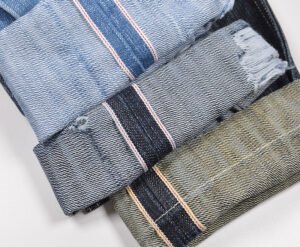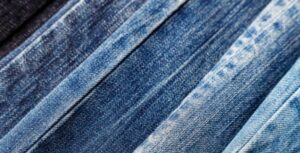01 Background of the denim fabric
Denim (French: Denim), also transliterated as denim, is a thick cotton gauze fabric specially used to make jeans. Denim originally only came in blue and was originally used as canvas. However, it now comes in many different colors and can be used to match different clothing.
The English name Denim of denim comes from Nîmes (Nîmes) in France, so the cloth produced locally is called de Nim, which means “from Nîmes”.
The warp yarn adopts size dyeing combined with one-step dyeing process. The special numbers are 80tex (7-inch count), 58tex (10-inch count), 36tex (16-inch count), etc. The special numbers of weft yarn are 96tex (6-inch count), 58tex (10-inch count). count), 48tex (12 inch count), etc., using 3/1 weave, and also using twill, plain weave or crepe weave denim. The gray fabric has been treated with anti-shrinkage finishing, the shrinkage rate is smaller than that of ordinary fabrics, the texture is tight, thick, and the color is bright. The lines are clear. Suitable for men’s and women’s jeans, denim tops, denim vests, denim skirts, etc.
In the 1980s, U.S. denim production accounted for 50% of global production. However, in the past decade, China, India, Pakistan, Malaysia, Turkey and Mexico have established a large number of denim production plants, and the United States and even The world’s denim production center has shifted to low labor cost countries in Asia. In 2000, China’s denim output was approximately 2,424t, and its imported indigo dye was 759t. In 2001, its output had risen to 2,717t, and its imported indigo dye had dropped to 702t.
02 Types of denim
Since the late 1970s, denim has experienced many major developments in China and has become an important producer of denim in the world. A large number of more advanced denim and denim clothing companies have basically been in line with international standards in terms of quality and variety, initially reversing the concept that Chinese denim products are “low-end products” in the international market.
Although the development and production of denim products in China started late, it started at a high level. It has air-jet spinning, automatic winding, ball warp dyeing, and shuttleless looms (a large number of rapiers, followed by projectiles, and then air-jet). , heavy-duty pre-shrinking and finishing machines and other advanced equipment, thus creating good conditions for the development of denim varieties and improvement of quality levels.
Slub Denim Fabric
When designing slub yarns with different yarn numbers, different slub thicknesses (compared to base yarns), slub lengths and pitches, single warp or single weft direction and both warp and weft directions are equipped with slub yarns. When normal yarns of different sizes or different sizes are properly matched and arranged, a variety of slub denim can be produced. After garment washing and processing, various hazy or clear strip-style denim garments can be formed. , welcomed by consumer groups with personalized needs. Early slub denim almost always used ring-spun slub yarn, because it can spin slub yarn with shorter length, smaller pitch, and relatively high density, which is easy to form a dense embellishment effect on the cloth surface, and Mainly meridional bamboo joints. With the development of market consumer demand, especially the two-way slub denim products with weft stretch, they are very popular in domestic and foreign markets. For some varieties, as long as the tissue structure is well designed, a single variety of ring-spun yarn can be used in the warp direction and an appropriate proportion of slub yarn can be used in the weft direction, which can also achieve the effect of two-way slub denim in both warp and weft directions.
This selvedge denim fabric has obvious heavy slubby texture, even distribution and a high-end feel.

Ring spun yarn
With the development and application of new technological equipment such as high-speed ring spinning, large packages, fine interlocking, and knotless yarns, the shortcomings of coarse yarn spinning such as short length, low production efficiency, and many knots have been solved. The situation in which the yarn used in denim is replaced by air-spun yarn is rapidly changing, and ring-spun yarn is likely to make a comeback. Because ring-spun yarn denim has some properties that are better than air-spun yarn, such as feel, drape, tear strength, etc., it is also due to the influence of people’s psychological return to nature and pursuit of the original developed denim style. The more important reason is that environmental protection After the spindle denim garments are polished and processed, the surface will show a hazy bamboo-like style, which is in line with the personalized needs of today’s denim garments. Ring-spun bamboo joints can spin shorter and denser bamboo joints, which also promotes the development momentum of ring-spun denim.
Weft yarns with elasticity
The use of spandex elastic yarn has developed denim varieties into a new field, which can make denim clothing both close-fitting and comfortable. Coupled with bamboo knots or different colors, denim products can be more suitable for fashionable and personalized consumer needs. Therefore, they have Great potential for development. The elastic elongation is generally between 20% and 40%. The size of the elastic elongation depends on the weave design of the fabric. The smaller the tightness of the warp and weft weave on the cloth machine, the greater the elasticity. On the contrary, under the condition that the tightness of the warp weave is fixed, Below, the greater the tightness of the weft elastic yarn, the smaller the elasticity. When the weft tightness reaches a certain level, elasticity may even be lost. In addition, the outstanding problem of finished stretch denim fabrics is that the shrinkage rate in the weft direction is too large, generally more than 10%, and in some cases even as high as more than 20%. Unstable fabric width brings great difficulties to clothing production. The first solution is not to make the elastic stretch too large when designing the product. Generally, it takes 20% to 30%, that is, to maintain a certain tightness in the warp and weft direction, and When pre-shrinking, appropriately increase the tension to cause the fabric to shrink significantly, thereby obtaining a lower residual shrinkage in the weft direction of the finished fabric. Another solution is to heat-set stretch denim after pre-shrinking. In this way, a more uniform fabric width and a more stable and lower weft shrinkage can be obtained to meet the requirements of garment processing and production.
Here recommend one very nice silver ID stretch selvedge denim fabric for selvage jeans maker: W185517
Chromatography of Jeans Fabric
In order to increase the color and luster changes of indigo denim varieties. For example, indigo over-dyed sulfur black, indigo over-dyed sulfur grass green, sulfur black green, sulfur blue, etc., to meet the individual needs of the market. At the same time, it also enables denim production plants to have new varieties of denim with patented characteristics to improve market competitiveness. What needs to be noted in this regard is to control the concentration of the mother liquor as much as possible to prevent excessive overflow of the dye liquor from causing waste of dye and expanding environmental pollution.
Special color of Denim Fabric-Indigo
Because clothing made of super indigo dyed or extra deep indigo dyed denim can obtain special effects of rich and bright colors after being washed and processed, it is widely welcomed by consumers. “Super Indigo” dyed denim has two major characteristics: extremely deep dyeing depth and extremely good color fastness to washing. The former refers to the amount of indigo dye dyed on the yarn per unit weight (generally expressed as the dye accounting for % of the dry weight of the yarn, referred to as the dyeing depth %). For example, the indigo dyeing depth of conventional denim warp yarns is 1% to 3%. , and the dyeing depth of “super indigo” needs to reach more than 4% before it can be called super indigo or extra deep indigo. The latter refers to the fact that “super indigo” dyed denim needs to withstand repeated sanding and washing for more than 3 hours, and its color can still reach or exceed the color depth of conventional dyed denim without sanding and washing, and its color is lighter than conventional dyed denim. Much richer and brighter. The color fastness to washing of indigo-dyed denim essentially depends on the penetration degree of the dye to the yarn, rather than the washing fastness of the dye itself (the wet rubbing fastness of indigo is only level 1), that is, the penetration of the core The better the degree, the better the color fastness to washing.

